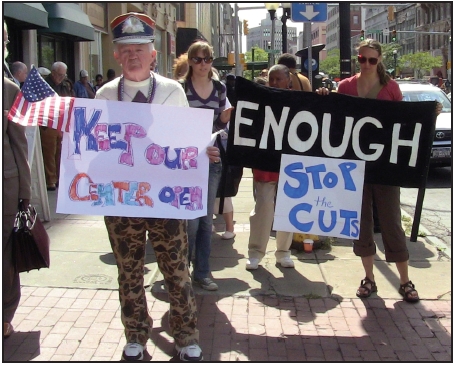Syracuse seniors were given just a few weeks notice that the Ida Benderson Center on Salina St. in downtown Syracuse—which many relied on as a home away from home—would be closing its doors for good. Shocked and aggravated, they took to the streets on September 19, rallying outside of City Hall with a crowd of local supporters. But their chants of “RESPECT YOUR ELDERS” and “SAVE OUR CENTER” fell upon deaf ears, and by the end of the rally, city hall officials had shut their windows.
Despite the seniors’ efforts to save the Center – including a petition and a head shaving – the city went through with its plans to close the facility on October 1. According to Mayor Stephanie Miner, the city could no longer afford to keep the Center open. Seniors are now being encouraged to visit the Salvation Army’s adult day care program several blocks away, but many are not happy with this solution.
Funding cuts like the one that caused the closing of the Ida Benderson Center frequently affect the elderly and working-class people. “It’s an assumption that [those affected by the cuts] wouldn’t have any reasonable or valuable perspectives to offer, or that they wouldn’t have any suggestions for how to solve problems,” said Denise Nepveux, a postdoctoral research fellow at Syracuse University’s Center for Human Policy, Law and Disability Studies. Nepveux was an active worker in the fight to keep the Ida Benderson Center open.
As Nepveux explains, humans have a right to recreation, and those in an adult day care program especially need support. “To deny that to people and to put them in a clinically driven program is really, really unfair,” she said. Some of the seniors are homeless, and relied on the Center for meals and a warm place to spend the day. One of the women Nepveux talked to said she had been living off of cereal since the Center closed.

The Ida Benderson Center is just one of many programs being cut in Syracuse and throughout cities across the country. Syracuse residents have experienced layoffs and school district budget reductions across the board. At H. W. Smith Elementary, twelve of the school’s 22 teacher’s assistants were reassigned throughout the district to fill vacancies left by layoffs.
A significant portion of these cuts comes from reductions in Community Development Block Grant programs, which fund local community programs like the Ida Benderson Center. In February, President Obama proposed a budget plan that would cut $1.1 trillion from the deficit over the next ten years. Since then, numerous government agencies and community organizations have undergone extensive funding cuts. About 1,200 communities in the US depend on Community Development Block Grants to develop their communities, and Syracuse is no different.
But while nearly all government programs are experiencing cuts, one in particular is not. The Defense Department actually benefited from the budget, making it one of the few agencies to receive an increase. The Department received $513 billion, a $5 billion increase from 2010. This includes $157.8 billion for overseas operations, and allows for 1.43 million active duty and 846,200 reserve troops.
The current recession’s length and severity depend in part on the continuation of wars. According to a March 2008 article from The Nation, every $1 billion we spend on education, healthcare, energy conservation and road building creates 50 to 100 percent more jobs than spending the same money on wars. In 2007 alone, the US government could have used its $138 billion Iraq budget to provide health insurance for 45 million Americans, build 400 schools, hire 30,000 schoolteachers, or weatherize 1.6 million homes to reduce energy consumption by 30%.
According to the War Resisters League, 48 percent of income taxes are put toward military spending, making it the greatest component in its budget. Compare this to a mere six percent spent on physical resources, including agriculture, non-military energy and environmental protection. It is shameful that the government can allocate money for destructive purposes, leaving senior citizens without a place to eat. This inconsistency begs the question: What are our government’s priorities?
For now, Syracuse seniors have formed a coalition called the Friends of the Ida Benderson Center. The group meets every Friday to stay in touch and discuss long-term solutions. With the help of the Benderson family, they are trying to raise funds to start a new program in the future. Anyone who would like to get involved can email: friends@idabenderson.org or call 315-715-8545.
“All we need money for is a small, warm, comfortable, safe place where we could gather around the table and talk to each other, and listen to each other, and help each other to cope with the struggles that we face as we age,” said Mary Lawler, who frequented the Center until its closing. She and Nepveux said they hope that they can continue and strengthen the seniors’ coalition. “We have to start small, but we’ll stick together and we’ll be a support to one another.”
Allison is a graphic arts and writing major at Syracuse University and a current SPC intern.





